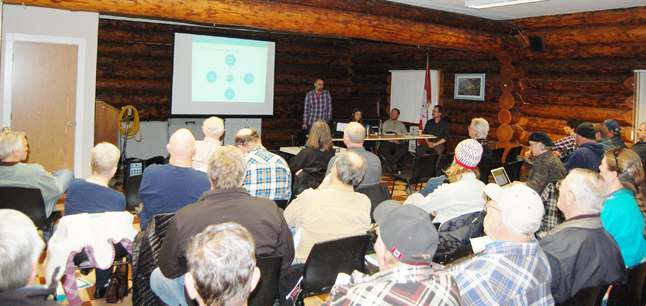
By David F. Rooney
NAKUSP — The Fish and Wildlife Compensation Program came under fire from area anglers and at least one conservationist during a recent meeting of fishermen in this village on the shores of Upper Arrow Lake. In particular, many of the almost 40 fishermen who were present are concerned about the declining kokanee population in the lake.
During a March 31 public meeting, FWCP Program Manager Trevor Oussoren and biologists Jeff Burrows, Steve Arndt and Marley Bassett reviewed the FWCP’s Nutrient Restoration Program, the Angler Survey and the impact of the Hill Creek Spawning Channel on the lake’s kokanee population. (Please click here to read their entire presentation.)
Bassett reviewed the Nutrient Restoration Program, which involves seeding the lake with nitrogen and phosphorous top increase the biomass available at the base of the food chain.
Since it started in 1998 the nutrient levels have remained steady and there was actually 300% increase in the biomass available to kokanee. However, the number of kokanee has radically declined in recent years.
“It’s a bit concerting, but one thing that’s happened in 2013 that changed the pace a little bit, is we see an increase in the size,” Bassett said. “Bigger fish are good. It means better in-lake survival and it means better reproductive success.”
Arndt, also a fish biologist, presented several graphs from the angler survey that illustrated how many people were fishing, what they caught and the size of the fish they landed. The surveys were undertaken at Shelter Bay, Nakusp and Castlegar.
Data for burbot, bull trout, rainbow trout and kokanee caught in the Arrow Lakes are troubling. While burbot catches have not changed much, bull trout and rainbow trout catches jumped after the initiation of the nutrient restoration program, but have now declined. There are more rainbow trout larger that 50 centimetres being hooked, but no rainbow trout weighing more than 15 pounds have been caught since 2005.
“I’m not saying nobody’s caught one, they just haven’t brought them into our station, so it’s not as common,” Arndt said.
The overall kokanee catch is very, very poor, he said, adding that not a single kokanee was caught at Shelter Bay or Nakusp last year.
“The biomass has been three times higher on average since we started nutrients,” he said. “Either you can have a whole lot of very small fish and not much of a fishery, or you can have fewer but bigger fish and have a bigger fishery.”
The bottom line for kokanee is that “If you want to have a kokanee fishery, you need to have bigger kokanee.”
However, that is problematic.
Jeff Burrows, manager of the Hill Creek Spawning Channel, said the high number of kokanee being spawned at Hill Creek appear to be suppressing the wild kokanee that should be spawning in other streams.
He said Hill Creek would now breed lower numbers of kokanee in hopes that will bolster the number and size of kokanee breeding in the wild.
“When Hill Creek fry suppress the wild fry and too many shrink down the size of the kokanee, there’s not much point of going at maximum capacity at Hill Creek,” said Burrows.
Will that have an effect on the kokanee population? One can only hope so.
“There programs don’t seem to be working,” said Revelstoke angler Peter Bernacki, who drove to Nakusp with friend and fellow fisherman Barry Ozero.
Former BC Hydro biologist Brian Gadbois of Revelstoke said it was apparent that “have flat-lined” and nowhere is that more evident than in streams near Revelstoke.
“Hill Creek has killed spawning in natural spawning channels,” he said. “In Revelstoke we used to have a school-based Kokanee Festival at Bridge Creek but for the last two years there hasn’t been a single kokanee in the creek,” he said. “We need to get those kokanee back.”
Gadbois also noted that while the fishery from Revelstoke to Castlegar is managed as a lake-based fishery, it should actually be operated as river-based fishery from Revelstoke to Shelter Bay.
“At this time of year the reservoir is low enough that from Revelstoke to Shelter Bay is actually a river, and the fishery is being managed as a lake fishery,” he said. “If it was managed as a river fishery, there would be closed seasons, especially at this time of year, especially in the fall.”
At the end of the meeting Oussoren told Gadbois and the four other Revelstokians who travelled to Nakusp for the meeting that the FWCP will have $900,000 for projects this year. Some of that money could finance small community-based projects in the Revelstoke area, he said.
Please click here to read the entire FWCP presentation.



